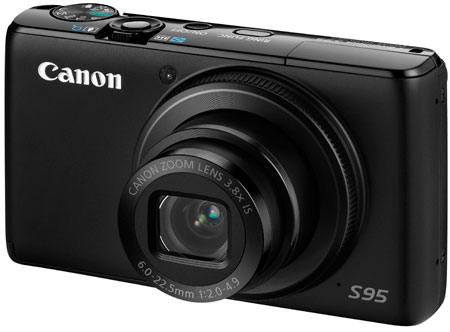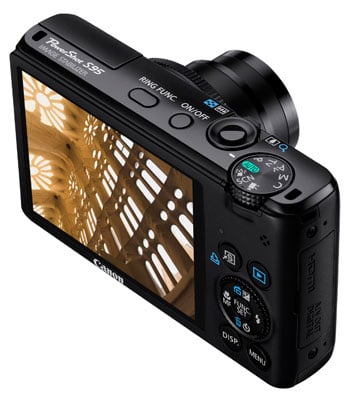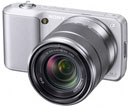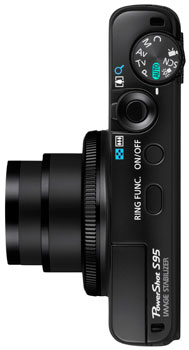Canon PowerShot S95
-
-
Written by Gordon Laing
Verdict
Canon’s PowerShot S95 subtly builds upon its predecessor to deliver one of the most compelling pocket cameras for enthusiasts. The core specification hasn’t changed, but a selection of minor upgrades address some of the issues facing the earlier S90, while others take inspiration from the best of the competition, most notably its major rival from Panasonic.
So with the PowerShot S95 you’re still getting a sensible 10 Megapixel sensor, brighter than average 28-105mm lens and detailed 3in screen packed into a compact body with a high degree of manual control and support for RAW files. To this, the new model adds in-camera HDR, Hybrid Image Stabilisation, more sophisticated Dynamic Range enhancements, Tracking AF, a variety of special effects, a choice of aspect ratios and a new finish to the body which makes it easier to grip.
Arguably the biggest new feature, and the one which most needed addressing on the earlier S90, is the ability to shoot 720p HD movies, which the S95 now complements with stereo sound. Overall there may not be enough to tempt existing PowerShot S90 owners into upgrading, but anyone in the market for a small but sophisticated camera will certainly be very tempted. So how well does it all work in practice?
 |
The PowerShot S95 is billed as a low light camera with its modest sensor resolution and bright lens focal ratio. There’s certainly no arguing with the latter – an f2.0 lens can gather twice as much light as one at f2.8, allowing you to shoot at half the sensitivity or double the shutter speed under the same conditions. Halving the sensitivity on a compact can make a big difference to the image quality, and it’s perfectly illustrated when shooting alongside the G12 under dim conditions. With both cameras zoomed-out to 28mm and locked to the same shutter speed, the S95 could employ a sensitivity of 400 ISO when the G12 would be forced to 800, and this would give the former a big advantage in quality.
The only caveat being the f2.0 aperture is only available when the S95 is fully zoomed-out to its widest angle. Like most compacts, the aperture decreases as the lens zooms-in, and by the time the S95 reaches its longest equivalent focal length of 105mm, the focal ratio actually becomes a tad slower than the G12 at its maximum of 140mm. So there’s no focal ratio benefit to the S95 at anything other than its widest focal lengths, but considering you’ll generally be using these for most shots under dim conditions, it remains a highly valuable feature.
As for the sensor, Canon’s tweaked it to support HD video, but the still-photo performance is essentially unchanged from the earlier S90. As such it delivers great results up to 200 ISO, looks fairly respectable at 400 ISO and is acceptable for many applications at 800 ISO – you can see a full report with sample images in our results and gallery pages. Our comparisons include the Canon IXUS 300 HS / SD4000 IS which also sports a modest 10 Megapixel sensor and bright lens, but the fractionally larger sensor in the S95 gives it a small advantage at higher sensitivities.
 | |
|---|---|
One of the delights of the earlier S90 was its degree of manual control and customisation. The S95 builds upon that with more options that can be assigned to the front lens ring and Shortcut button, along with swapping the thumb wheel for one with stepped feedback. Small things like now being able to assign AE Lock to the Shortcut button and feel how many clicks you’ve turned the thumb wheel by make a big difference to day-to-day operation. Meanwhile the AUTO mode now detects more shooting conditions, while leaving full control in PASM modes if you prefer.
An unexpected but welcome update is finding the earlier i-Contrast function expanded into separate highlight and shadow protection settings, which as you can see on our first page, can make a big difference in challenging conditions. The new in-camera HDR mode may require a tripod and is nowhere near as powerful as creating them manually, but offers a quick fix which can be effective at boosting shadow areas.
The new 720p HD movie mode was an essential upgrade for this camera, and brings the S95 in-line with the video capabilities of most 2010 compacts. Annoyingly you still can’t optically zoom while filming, but the quality remains pretty good, and as you’ll see in our sample clips, the slightly larger sensor minimises highlight clipping (with subsequent vertical streaks) which plague many CCD based compacts.
Several new features on the S95 feel like a direct response to the rival Panasonic LX model. As such, the S95 now sports AF tracking, which works like the LX5, along with a broader choice of aspect ratios. The latter don’t work so well on the S95 though as unlike the LX5, they simply involve cropping and therefore offer nothing you can’t do in software later.
Canon may have also accelerated the continuous shooting speed, and unlike the LX5, the S95 can keep shooting full sized JPEGs until it runs out of memory. But, and the big but, is that the speed is only 2fps. That may be twice as fast as the S90, but remains far too slow to be useful for action photography. If you’re desperate for quicker frame rates you could set the S95 to Low Light mode, but you’ll have to accept a drop in resolution to 2.5 Megapixels. Fitting the S95 with a CMOS sensor could have delivered much quicker burst rates, not to mention 1080 video capabilities, so it’ll be interesting if this is the future direction for this product – although as seen on Panasonic’s Lumix FZ100, fitting a CMOS sensor could have a detrimental effect on still photo quality.
Ultimately for all the tweaks, the best thing about the PowerShot S95 remains its compact size and low weight. It may not be the slimmest compact on the market, but it is the smallest one to offer full manual control, a bright lens and RAW recording, and crucially you can squeeze it into just about any pocket. This is the key selling point of the S95 and an important difference between it and the Panasonic Lumix LX5. The LX5 is technically a superior camera with greater features and performance, but it’s just a little too big to fit into a small pocket, while the clip-on lens cap can’t help but slow you down when getting the camera ready for a shot or packing it away.
These may seem like trivial points, but once you have to carry a camera in a larger pocket or small bag and remove a lens cap for use, you need to ask yourself if you’d be better-served by one of the new breed of mirrorless ‘EVIL’ compacts. They may be bigger, heavier and more expensive than the LX5, but not so much to rule them out, and by sporting DSLR-sized sensors and removeable lenses, they arguably offer more to enthusiasts. Meanwhile, the PowerShot S95 neatly dodges the issue by being comfortably smaller than any EVIL compact and genuinely pocketable.
So before wrapping-up, how does the S95 compare against two key rivals?
Compared to Panasonic Lumix LX5
 | ||
Panasonic’s Lumix LX5 is arguably the PowerShot S95’s main rival, as both pack sensible resolutions and bright lenses into small bodies with plenty of controls for enthusiasts. While both share similar-sized 10 Megapixel sensors, 3in / 460k screens and bright f2.0 focal ratios when zoomed-out though, there are considerable differences to weigh-up between them.
Most obviously the PowerShot S95 is smaller. By employing a body that’s shorter in every dimension with fewer protrusions and a lighter weight, the S95 looks and feels noticeably smaller in use – and crucially it’ll squeeze into smaller pockets than the LX5. The absence of a lens cap also makes it thinner, not to mention quicker to power-up and down again. The lens may not zoom quite as wide (28mm vs 24mm), but it does zoom a little longer (105mm vs 90mm).
The PowerShot S95 also features two control wheels, with one thumb wheel on the back and one programmable ring around the lens barrel, along with twin microphones for stereo sound. The S95’s motorised flash can also raise and (neatly) lower itself automatically, and some may prefer the screen being the same 4:3 shape as the best quality photo setting. In terms of image quality we additionally preferred the S95 above 400 ISO which avoided many of the LX5’s undesirable artefacts. The S95 also features an HDR mode which combines three exposures automatically, and the option to view RGB in addition to brightness histograms.
In its favour, the Lumix LX5 features a more comfortable grip, a hotshoe for external flashguns, an accessory port for an optional electronic viewfinder (and maybe other accessories in the future), a wider lens, a brighter focal ratio when zoomed-in, finer zoom increments, the choice of aspect ratios without compromising the field-of-view, optical zooming and manual control over exposures for video, adjustable spot focusing options, fast flash-sync speeds, double the battery life and quicker focusing in our tests. You can also mount filters with an optional tube accessory, although it should be noted third-party filter adapters are also available for the S95 from companies like Lensmate.
While there are some feature advantages to the S95, most would agree the LX5 ultimately has more for the enthusiast. The big question then concerns size and speed of operation. The LX5 is larger than the S95 and slower to get ready thanks to its clip-on lens cap. If neither of these bother you, then the LX5 is arguably the best compact for enthusiasts with a small sensor and fixed lens. Just carefully weigh it up against EVIL models like the Sony NEX-3 below. See our Panasonic Lumix LX5 review for more details.
Compared to Sony Alpha NEX-3
 | ||
There are a number of ‘EVIL’ compacts featuring DSLR-sized sensors and removeable lenses on the market today, but for comparison here we’ve chosen the Sony Alpha NEX-3 as one of the most compelling alternatives to the PowerShot S95 at the time of writing.
In its favour, the NEX-3 features a considerably bigger sensor, indeed one that’s the same size as in most DSLRs. This means much lower noise at higher sensitivities, higher dynamic range and the potential for shallower depth-of-field effects – it also has 40% more pixels in total. The NEX-3 also features a removeable lens mount, and while it doesn’t have a 28-105mm f2.0-4.9 zoom, there’s simply the potential for many more lens options. Both the NEX-3 and PowerShot S95 feature 3in screens, but the Sony’s is more detailed with a 920k panel. The NEX-3 additionally boasts a number of innovative options which combine multiple exposures in-camera to reduce noise, minimise motion blur or even generate panoramas, including 3D options. The continuous shooting is also quick at up to 7fps, and if you opt for the pricier NEX-5 version, you’ll enjoy 1080p movies. And while neither NEX has a flash hotshoe, Sony has previewed an optional flashgun, not to mention a high quality stereo microphone, whereas the S95 is limited to a small popup flash and internal microphones.
In its favour, the PowerShot S95 is much smaller and lighter, especially when compared against the NEX with a kit zoom. While the smallest NEX lens has a fixed focal length and its kit zoom is average in specification, the PowerShot S95 boasts a built-in 28-105mm f2.0-4.9 zoom and few if any concerns over dust getting onto the sensor. Its larger inherent depth-of-field will also minimise focusing errors on general snaps, although equally limit the potential for blurred background effects. Enthusiasts will also prefer the controls, customisation and user interface on the PowerShot S95, and by not having a clip-on lens cap, you’ll be ready for action and putting it away again more quickly. Finally, the PowerShot S95 costs approximately one quarter less than the NEX-3, and unlike all the EVIL (and DSLR) cameras to date, it can also fire its shutter in virtual silence.
Ultimately the PowerShot S95 is much smaller, lighter and cheaper than the NEX-3 and other EVIL compacts, while also featuring a bright and wide 28-105mm f2.0-4.9 zoom. If you’re willing to increase your budget and carry a larger camera though, you can enjoy a much larger sensor and removeable lenses, not to mention the other benefits listed above. It’s a compelling proposition for enthusiasts.
For more details see our Sony Alpha NEX-3 / 5 review.
Canon PowerShot S95 final verdict
Canon’s PowerShot S95 may not represent a huge leap forward from its predecessor, but remains an ideal choice for enthusiasts who want a pocket camera without compromising on control and features. Think of it as an IXUS / ELPH for the more demanding customer. The person who fondly gazes at the attractive bodies of models like Canon’s IXUS 130 / SD1400 IS, but wishes they had manual control, RAW file support, a big high resolution screen and a fast, bright lens. Written down it sounds like a tall order, but one the S95 delivers on.
 | |
|---|---|
The differences between the S95 and S90 may be subtle, but Canon’s addressed our biggest complaint by equipping the new model with HD video. You may still be unable to optically zoom when filming, but having 720p and stereo audio makes the S95 a much more complete camera than its predecessor. The greater customisation, tweaked controls and improved body finish also enhance day-to-day operation.
As we said above though, the thing which makes the S95 really special is its small size and low weight. Unlike any other camera aimed at enthusiasts, including Canon’s own G12 and Panasonic’s LX5, this is a model you can squeeze into just about any pocket. There really isn’t any time when the S95’s left at home because it’s a bit too big or inconvenient – it goes everywhere with you, regardless of your clothing or bag.
The appeal of a smaller body cannot be underestimated. Sure the Lumix LX5 may enjoy a number of key advantages including a flash hotshoe, quicker AF and superior movie controls to name but three, but with both on our desk during the test period we found ourselves reaching for the S95 much more often than its bigger rival. Where the LX5 requires some thought as to where you’ll put it when you go out, whether it’s a garment with a bigger pocket, a bag or a strap, the S95 will simply slip or squeeze into pretty much whatever you’re wearing without a fuss.
This is a critical advantage of the S95 – indeed in today’s market where DSLR sensors can be found in relatively compact bodies, the PowerShot S95 feels the most relevant in its peer group. It may not offer the same degree of control and features as the LX5, nor the quality of ‘EVIL’ compacts like the Sony NEX-3, but with genuinely pocketable dimensions, it offers a more portable proposition to models with bigger sensors. In contrast the LX5, while no giant, is just physically too close to more powerful models for our liking.
That’s the bottom line. If you’re happy to accommodate the LX5’s larger dimensions and don’t consider the lens cap an inconvenience, it’s a technically superior camera. But if size is an issue and you want a genuinely pocketable compact with enthusiast features and performance, then the PowerShot S95 is your best choice. What started as a sleeper model in last year’s range has now become one of the most compelling in the current Canon line-up and comes Highly Recommended.
|
Good points Pocketable body with great controls and customisation. 3.8x zoom with bright f2.0 aperture at 28mm. Great quality 3in / 460k screen. Full manual control, RAW files and 720p HD movies. Bad points 
| Scores (relative to 2010 enthusiast (non-EVIL) compacts) | |||
Build quality: Image quality: Handling: Specification: Value: Overall:
|
18 / 20 18 / 20 17 / 20 17 / 20 18 / 20 88% | |||




